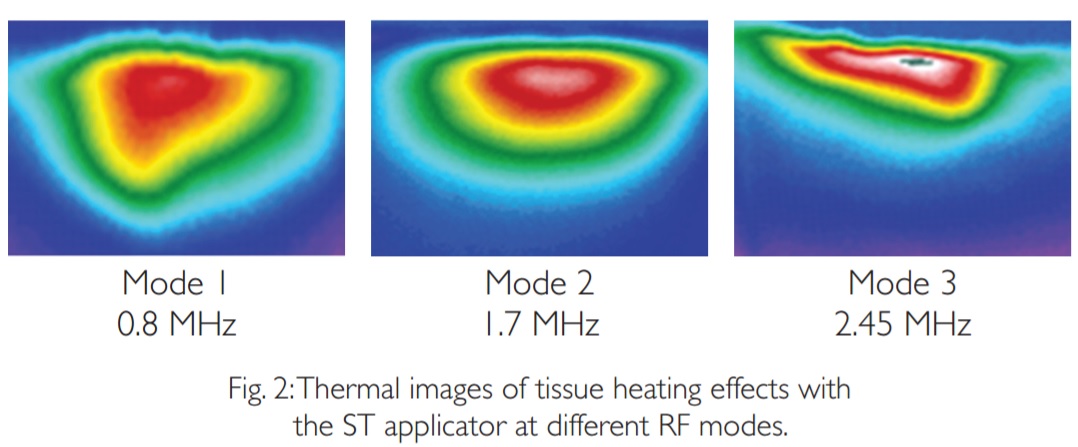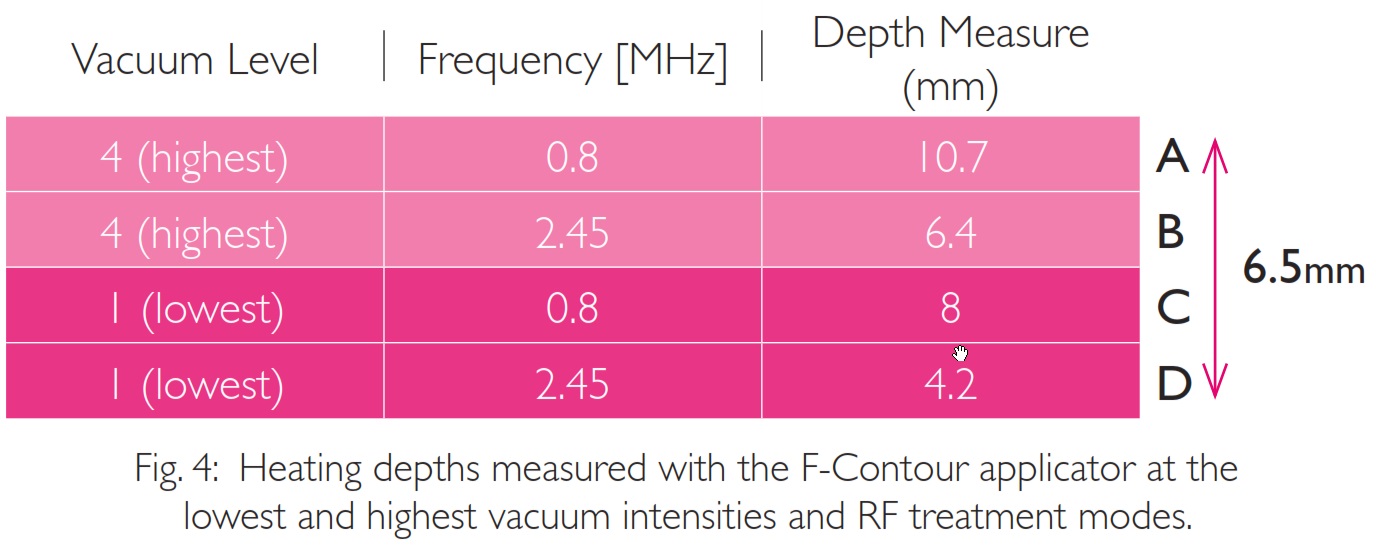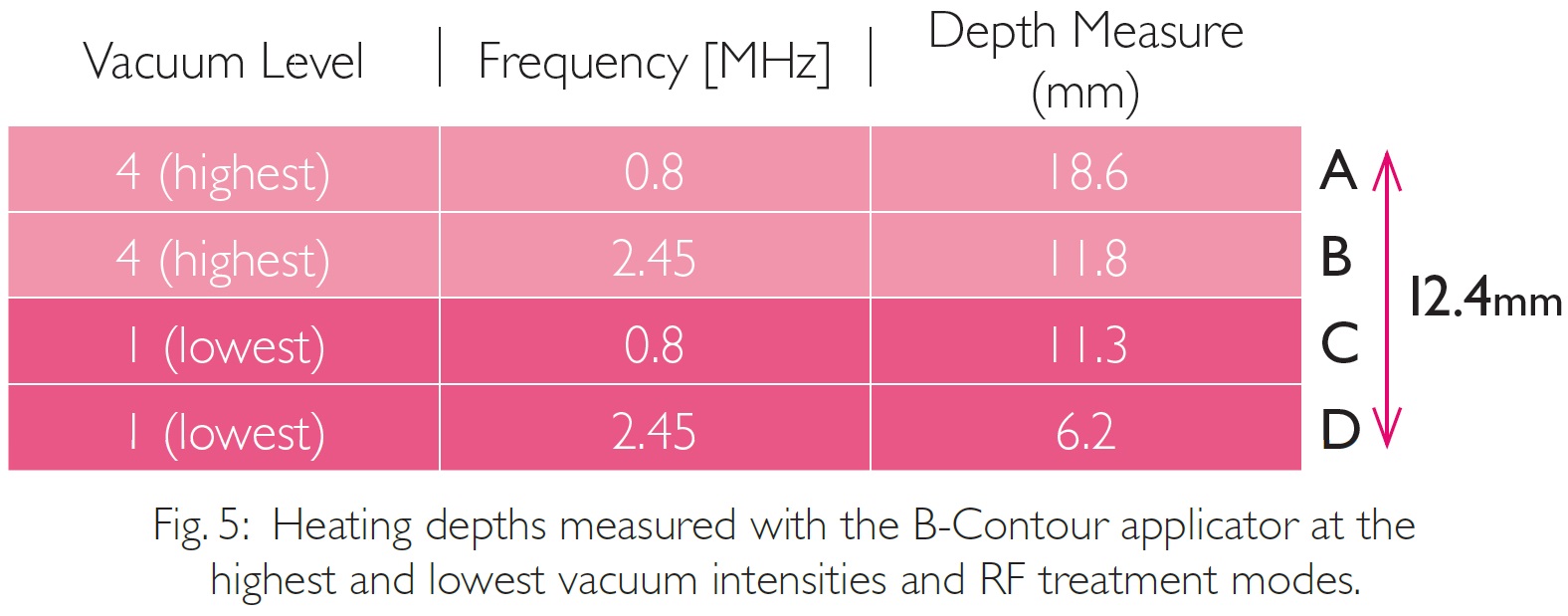CORE Technology: Understanding Penetration Depths of Different RF Modes
- Type: Free
- Download
CORE™ Technology: Understanding Penetration Depths of Different RF Modes
Mor Cohen M.Sc., Udi Bar-Yosef, PhD. ABSTRACT: Reaction™'s CORE™ technology incorporates unique variable frequency settings to precisely control RF penetration depth in underlying tissue. This article explains the theoretical basis for this technology and presents the results of an in-vivo clinical study conducted to confirm this theory on the actual thermal effects obtained with the Reaction™ system on the skin of domestic porcine. A range of 3.9 to 18.6 mm was found for tissue heating depths at the different RF frequencies, different vacuum intensity levels applied and different applicators available with the system.
Introduction
Radiofrequency (RF) energy is a form of electromagnetic energy. When applied to tissue, it produces electromagnetic fields, causing the oscillation of molecules within the tissue, which results in the generation of heat. This heat effect has been extensively used in surgery for hemostasis and tissue ablation (electro-surgery), but more recently it has been applied for various aesthetic applications such as treatment of cellulite, tightening of lax skin, elimination of wrinkles and rythids and for the reduction of thigh and buttocks circumference.
Radiofrequency can be applied to tissue by using either two points on the tip of a probe (bipolar) or between a single electrode tip and a grounding plate (monopolar). Since bipolar energy is more localized, less energy is required to achieve the same heating effect (Ref 1). Radiofrequency aesthetic effects are based on mild heating of the skin’s underlying network of collagen and elastin fibers which can lead to collagen shrinkage and thickening, improving skin’s firmness and elasticity. To this end, depth control of the heating effect is highly desired since different aesthetic imperfections originate from different skin layers and in different anatomical sites the thickness of skin layers varies significantly. The ability to control heating depth is particularly desired in systems which are designed to treat both body as well as facial skin. Reaction™'s CORE™ technology introduces a new dimension in RF aesthetic treatments that allow independent heating depth control, in addition to the previously available means of energy and probe geometry. CORE™ achieves heating depth control by applying three different RF frequencies, 0.8 MHz, 1.7 MHz & 2.45 MHz, as well as a combination of all three. These four different frequency modes can be independently chosen by the operator for any energy and probe setting to control the heating depth effect as required with each patient and each application. In addition, CORE™ technology incorporates tissue vacuum massage which assists in achieving the desired aesthetic skin effects.
Electromagnetic Field Penetration
The penetration depth of RF energy depends on the electromagnetic wave frequency, the permeability of the tissue and the tissue's conductivity. This dependence is determined by the following equation:

From this equation it can be seen that the depth of penetration in millimeters is inversely proportional to the square root of the frequency. Hence, lower frequencies have a higher penetration rate. To test this heating depth dependence on RF mode, Reaction™'s CORE™ based system was studied in-vivo on male porcines while recording skin temperature with a video thermal camera.
Materials and Methods
An in-vivo study was conducted on the skin of two male domestic porcine using a thermal video camera (TiR3FT, Fluke, USA) to determine the tissue heating depth effects at the different RF frequencies available with CORE™ technology in the Reaction™ system. The thermal video camera has a temperature measurement range of -20º-100ºC with a sensitivity of 0.07ºC and an accuracy of ±2 °C. Animals involved in the study were approximately 6 months old and weighed 146.5 and 157 kg and were under full anesthesia by inhalation of Isoflurane (2%-3%). After performing a large full skin incision, the Reaction™ system was applied on animal skin using protocols similar to those recommended for the different human aesthetic applications. The three different RF applicators were tested. B-Contour applicator is intended for large body areas combining RF with vacuum massage, F-Contour applicator is intended for facial and small body areas combining RF with vacuum massage and the ST applicator is intended for body and facial treatments using RF energy only. Vacuum level, where applicable, can be set at 4 different levels corresponding to a maximum vacuum intensity of 500 mbars. RF intensity level, with F or B- Contour applicators can also be set at 4 different levels corresponding to a maximum power of 50 Watts and up to 125 Jcm3 for ST applicator and RF frequencies can be set at 4 different modes corresponding to 0.8 MHz, 1.7 MHz, 2.45 MHz and a combination of all three. To investigate the effect of frequency on tissue heating depth, treatments were performed at fixed RF and vacuum intensities and a fixed number of pulses while varying only the RF mode between the three available frequencies. Thermal video imaging recording of the incised skin began with the first pulse and was stopped when the thermal effect faded, approximately 2 minutes after last RF pulse. As in the standard clinical protocol for patients, external skin temperature was monitored with a separate IR thermometer and throughout the experiments remained below 43ºC. For comparison purposes, heating depth was arbitrarily defined as the depth at which skin tissue temperature reached 4ºC above tissue baseline temperature which was typically~28ºC.
Results
Heating depth results obtained for the different RF frequencies confirm the theory that RF penetration depth in tissue is an inverse function of frequency. For all the probes tested, heating depth observed was greatest for the lowest RF mode applied and smallest for the highest frequency. Figure 2 presents thermal images of the tissue heating depths obtained with the ST applicator set at RF intensity level 3 and applied with a single pulse. Heating depths measured were 7.2 mm, 5.1 mm & 3.9 mm corresponding to frequencies of 0.8 MHz, 1.7MHz and 2.45 MHz.

Figure 3 presents thermal images of the tissue heating depths obtained with the F-Contour applicator set at RF intensity level at 4, vacuum intensity level at 4 and applied at 6 pulses. In this case heating depths measured were 10.7 mm, 7.9 mm and 6.4 mm, corresponding to frequencies of 0.8 MHz, 1.7 MHz and 2.45 MHz, respectively. The maximum difference between the application of vacuum intensity 4 and Mode I to that of vacuum intensity 1 and Mode 3 equals 6.5 mm, as is demonstrated in Figure 4.


Finally, with the B-Contour applicator which has the largest distance between the electrodes, tissue heating depths obtained were 18.6 mm,14.1 mm & 11.8 mm for 0.8 MHz, 1.7 MHz and 2.45 MHz respectively. The maximum difference between the application of vacuum intensity 4 and Mode I to that of vacuum intensity 1 and Mode 3 equals 6.5 mm, as is demonstrated in Figure 5.

DISCUSSION
The in-vivo study conducted on porcine skin with the Reaction™ CORE™ system clearly demonstrated an inverse relationship between tissue heating depth and RF mode. Figures 4,5 illustrate that the incorporation of the vacuum mechanism has a critical impact on the RF penetration depth. The increased intensity level of the vacuum function alone contributes to an increased penetration depth of up to 7.3 mm with the B-Contour applicator. Based on the equation presented in Figure1, heating depth should be inversely proportional to the square root of the frequency; 100%, 68.6% and 57.1% for 0.8 MHz, 1.7 MHz and 2.45 MHz, respectively. In Figure 4 a close correlation between the theoretical and measured relationship can be seen, indicating the validity of this study's theory.

The results of this study affirm that CORE™ technology affords a new dimension in tissue heating depth control not previously available with any radiofrequency aesthetic system. A total heating depth range from 3.9 mm to 18.6 mm was measured for the treatment parameters used in the study on porcine skin. This capability should be significant in optimizing treatment parameters for different clinical indications, different anatomical sites and varying human skin characteristics. The clinical experience accumulated with CORE™ technology should allow precise tailoring of tissue heating effects for these different circumstances. For example, thickness of the dermis may vary from less than 2 mm to almost 5 mm in patients and different anatomical sites, while some applications, like cellulite, require deeper heating of the subcutaneous layers and others, like rhytids, require shallower heating of the dermis. Using the Reaction™ system in-vivo on porcine skin and applying the standard human treatment protocols, dermal and subdermal tissue heating was achieved with no adverse effects observed. This may be a further indication to the safety and efficacy of this technology beyond clinical study results already published.
SUMMARY
The unique variable frequency capability in Reaction™'s CORE™ technology has been demonstrated to affect different tissue depths at different RF modes and vacuum intensity levels.A total heating depth range from 3.9 mm to 18.6 mm was measured for the treatment parameters used in this in-vivo study on porcine skin.This capability, in addition to the ability to vary tissue heating effects by changing RF intensity level, vacuum intensity level and applicator configuration, allows utmost control when performing the full range of available RF aesthetic applications on different body areas and patient types.
 Tecar
Tecar Shock Wave
Shock Wave Plasma
Plasma Laser
Laser Tesla
Tesla Nikola
Nikola Kayser
Kayser Fusion
Fusion





